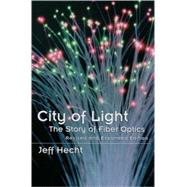
Note: Supplemental materials are not guaranteed with Rental or Used book purchases.
Purchase Benefits
Looking to rent a book? Rent City of Light The Story of Fiber Optics [ISBN: 9780195162554] for the semester, quarter, and short term or search our site for other textbooks by Hecht, Jeff. Renting a textbook can save you up to 90% from the cost of buying.
| The Sloan Technology Series | vi | ||||
| Preface to the Paperback Edition | vii | ||||
| Preface | ix | ||||
|
3 | (9) | |||
|
12 | (16) | |||
|
28 | (6) | |||
|
34 | (12) | |||
|
46 | (14) | |||
|
60 | (16) | |||
|
76 | (16) | |||
|
92 | (11) | |||
|
103 | (14) | |||
|
117 | (14) | |||
|
131 | (16) | |||
|
147 | (13) | |||
|
160 | (16) | |||
|
176 | (25) | |||
|
201 | (15) | |||
|
216 | (11) | |||
|
227 | (12) | |||
|
239 | (18) | |||
| Appendix A. Dramatis Personae: Cast of Characters | 257 | (8) | |||
| Appendix B. A Fiber-Optic Chronology | 265 | (14) | |||
| Notes | 279 | (50) | |||
| Index | 329 | ||||
| Photo gallery follows page | 116 |
The New copy of this book will include any supplemental materials advertised. Please check the title of the book to determine if it should include any access cards, study guides, lab manuals, CDs, etc.
The Used, Rental and eBook copies of this book are not guaranteed to include any supplemental materials. Typically, only the book itself is included. This is true even if the title states it includes any access cards, study guides, lab manuals, CDs, etc.